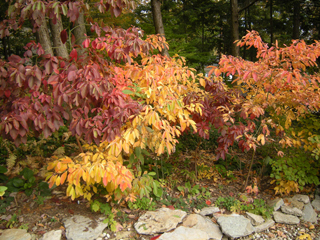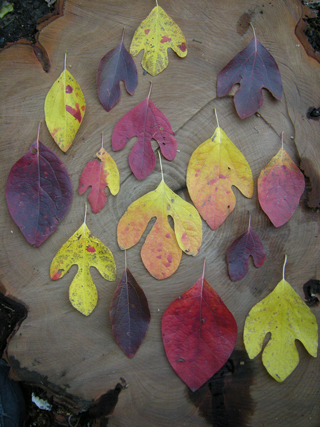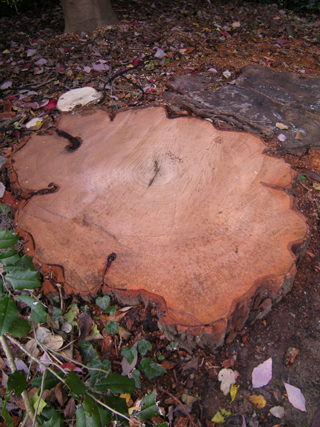Human Flower Project
Sassafras ~ Four Score and Four
Time turns a grand tree into a coat rack, and then it’s gone. Thank you, Allen.

Sassafras albidum: The next generation
Photo: Allen Bush
By Allen Bush
After record August rains (can you picture 6 ½ inches in 90 minutes?) I was ready to believe this was some sort of comeuppance for the one of coolest Julys on record. Not recording a single day in the 90s, in the heat of summer, was unheard of around Louisville. I imagined it must be like this on the coast of Maine. Then the record rains came. And then, of course, it got dry for the next six weeks. This is the way it goes.
Near the end of September I said good-bye to a sassafras (Sassafras albidum) tree at home. It had been a steady presence in good times and hard times for many years. To accompany my grief, the rains resumed again in mid-October – well, steady bone chilling drizzle, anyway – a real insult to my hopes for a curative Indian summer. Finally, there was a break the week before Halloween. The sugar maple two doors down turned bright orange, in clear view of our family room. The tall spikes of blue-purple monkshood in our garden looked regal, standing at attention. The white blooms of Cyclamen coum and the rain lilies Zephyranthes candida were at my feet. So were the purple colchicums. The golden larch Pseudolarix amablis was starting to turn. Pumpkin vines had been scorched by a light frost that missed the flowering tobacco Nicotiana sylvestris.
 Mitten leaves—other leaf shapes, too—of Sassafras albidum
Mitten leaves—other leaf shapes, too—of Sassafras albidum
Photo: Allen Bush
Since Rose and I moved into the house on Top Hill Road fifteen years ago, we’ve had the pleasure of this special sassafras. The variable foliage shapes look like leaf mittens; and the fall colors can be a band of colors: red, yellow, orange and red-brown. When we first laid eyes on the house, and tree, it was the dead of winter. I’m a journeyman on bare bones winter woody plant identification by bark and bud, and this big tree out back had me stumped. Its deep furrowed corky bark wasn’t a giveaway, nor were its fat olive green buds; but some leaf litter at its base provided the clues I needed. The leaves can be different shapes.
I was thrown off base since I’d usually associated sassafras trees as fifty footers – no bigger, I thought. This one, just outside the dining room bay window was seventy feet tall. (The national champion in Owensboro, KY is 75’ tall, according to Mike Dirr’s Manual of Woody Landscape Plants.) Ours had been in steady decline for years. In spite of loving care, the tree, notably the last remaining massive trunk (a whopping 30” diameter caliber at its sawed-off base), was given last rites less than a month ago. It appears by ring counts to have been eighty-four years old.
 The stump of an octogenarian, 30 inches in diameter.
The stump of an octogenarian, 30 inches in diameter.
Photo: Allen Bush
We never knew the sassafras as a stately presence. It was ragged thing from the first meeting. It didn’t show-up on the original 1938 lot survey. It may have been little more than a forsaken volunteer. Or maybe the surveyor ignored it because he didn’t know what it was. An American Elm and a White Ash made the plat but were sick from disease when we moved-in, more than a half century later. They lasted only a few years before they were given the chop.
Since we came to know the sassafras, the original thick twin trunks were pruned heavily and looked like a huge, misshapen coat rack. Hanging from ropes, or stretching out of lift buckets, Paul Clinton and Robert Rollins over the years took-out the dead and strengthened what was left. A species notorious for dropping twigs and small limbs, this sassafras lost none during the huge, historic ice storm last January, a testament to good tree work. There was some hope (all mine) when we moved in that our sassafras might improve and survive, but both these expert arborists knew better. They didn’t want to say there was no chance, but they acknowledged that its best days were behind it.
I easily imagined it as a proud specimen prior to 1995, before we came. Ours had stood witness, high on the hill, untouched by the 1937 flood, while Beargrass Creek below us, a tributary to the Ohio River a mile downstream, and barely wide enough to skip a stone across, grew nearly a half-mile wide. This mighty sassafras withstood the 1974 tornado that took down a huge oak in the front yard, according to Mrs. McNair, the home owner from 1940 until 1995. The vicious winds wasted much of the nearby Olmsted-designed Cherokee Park that is still recovering. The freezing cold winters in the late seventies, when temperatures dipped to below zero for weeks and the Ohio River froze over hard, didn’t faze it. And it didn’t seem bothered by droughts in the late ‘90s when native deciduous trees died on the ridge tops.
I don’t know if eighty-four years is a ripe old age for sassafras but it has not given-up the ghost, entirely. Its stoloniferous roots now extend 100’ away. It sent-up slender suckers last spring and a colorful, small grove, perfectly happy, survives just down the hill from a big, bare stump. It’s a happy ending after all.
Comments
Beautiful tree and I loved the happy ending. Thank you for sharing this story.
Allen,
Just back from the South Carolina Low Country where we made shrimp gumbo—with file. Turns out that this thickening spice, adding “calabogie” dark color and weird woodsy flavor, comes from sassafras leaf.
Too late, I fear, to harvest your trees this year unless some haven’t turned yet, but it is a fall-time harvest. Here’s a good link I found:
http://generalhorticulture.tamu.edu/prof/Recipes/File-Sassafras/file.html
That’s a new one on me. The leaves are gone but I might try this next year… Thanks, Julie. And thanks Georgia and Lubna.


I heart sassafras leaves. Thanks for sharing this story.